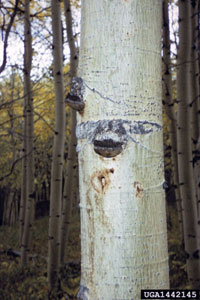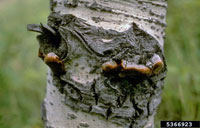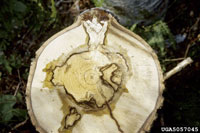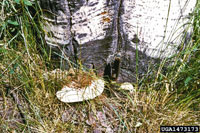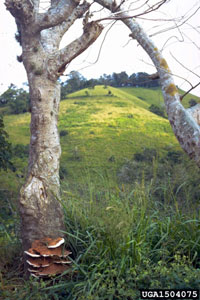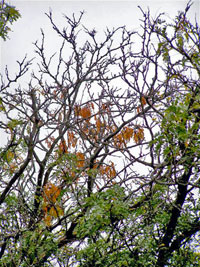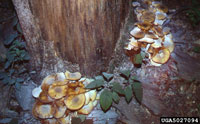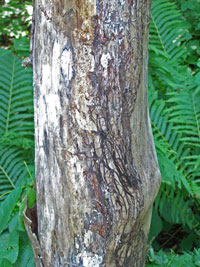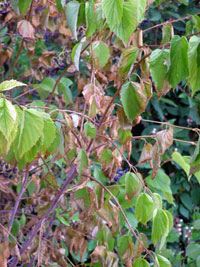Extension > Garden > Diagnose a problem > What's wrong with my plant? > Deciduous Trees > Poplar > Fungi growing on trunks or branches
Poplar > Trunk/Branches > Fungi growing on trunks or branches
1 of 3
Trunk and limb rot
Phellinus tremulae
- Fungal fruiting bodies arise along the stem, near a pruning wound, crack or other wound
- Fruiting bodies are up to 8 inches wide to 6 inches thick; lower surface at 45 degree angle
- Fungal surface is pale brown when young to black and crusted when aged
- The canopy may show no symptoms or may have small yellowing leaves/dead branches depending on the extent of the trunk decay
- In cross section of the trunk, the wood at the center is discolored, soft, crumbling, stringy or spongy
- More information on Trunk and limb rot
2 of 3
Ganoderma root and butt rot
(aka. artist's conk)
Ganoderma applanatum
- Fungal conks, a semicircle shelf fungi, can be found from the base of the tree up to 3 feet high on the trunk
- Conks are reddish brown and shiny on top, white and porous underneath, a rim of white may be visible on the edge of
growing conks - Infected wood at tree base is white, soft, stringy or spongy
- Infected trees frequently break or fall over in storms
- Leaves are smaller in size and turn yellow earlier than normal
- Canopy appears thin with few leaves and multiple dead branches
- More information on Ganoderma butt rot
3 of 3
Armillaria root rot
Armillaria spp.
- Clusters of honey-colored mushrooms may grow at the base of the tree in fall
- Wood is decayed, white, soft and spongy, and this may extend from the base of the tree well up into the trunk
- Infected trees have poor growth, dead branches in the upper canopy, undersized and/or yellow leaves
- Flat white sheets of fungal growth (mycelia fans) grow between the bark and sapwood at the base of infected trees
- Thick black, shoestring-like fungus can sometimes be seen under the bark, around roots and in the soil around the base of the tree
- More information on Armillaria root rot



